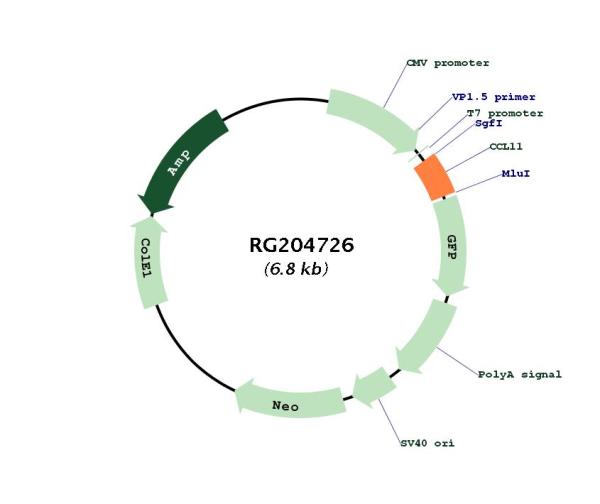Eotaxin (CCL11) (NM_002986) Human Tagged ORF Clone
CAT#: RG204726
- TrueORF®
CCL11 (tGFP-tagged) - Human chemokine (C-C motif) ligand 11 (CCL11)
ORF Plasmid: DDK
Lentiviral Particles: DDK DDK w/ Puro mGFP mGFP w/ Puro
"NM_002986" in other vectors (6)
Specifications
| Product Data | |
| Type | Human Tagged ORF Clone |
| Tag | TurboGFP |
| Symbol | Eotaxin |
| Synonyms | SCYA11 |
| Vector | pCMV6-AC-GFP |
| E. coli Selection | Ampicillin (100 ug/mL) |
| Mammalian Cell Selection | Neomycin |
| Sequence Data |
>RG204726 representing NM_002986
Red=Cloning site Blue=ORF Green=Tags(s) TTTTGTAATACGACTCACTATAGGGCGGCCGGGAATTCGTCGACTGGATCCGGTACCGAGGAGATCTGCC GCCGCGATCGCC ATGAAGGTCTCCGCAGCACTTCTGTGGCTGCTGCTCATAGCAGCTGCCTTCAGCCCCCAGGGGCTCGCTG GGCCAGCTTCTGTCCCAACCACCTGCTGCTTTAACCTGGCCAATAGGAAGATACCCCTTCAGCGACTAGA GAGCTACAGGAGAATCACCAGTGGCAAATGTCCCCAGAAAGCTGTGATCTTCAAGACCAAACTGGCCAAG GATATCTGTGCCGACCCCAAGAAGAAGTGGGTGCAGGATTCCATGAAGTATCTGGACCAAAAATCTCCAA CTCCAAAGCCA ACGCGTACGCGGCCGCTCGAG - GFP Tag - GTTTAA >RG204726 representing NM_002986
Red=Cloning site Green=Tags(s) MKVSAALLWLLLIAAAFSPQGLAGPASVPTTCCFNLANRKIPLQRLESYRRITSGKCPQKAVIFKTKLAK DICADPKKKWVQDSMKYLDQKSPTPKP TRTRPLE - GFP Tag - V |
| Restriction Sites |
SgfI-MluI
Cloning Scheme for this gene
Plasmid Map

|
| ACCN | NM_002986 |
| ORF Size | 291 bp |
| OTI Disclaimer | Due to the inherent nature of this plasmid, standard methods to replicate additional amounts of DNA in E. coli are highly likely to result in mutations and/or rearrangements. Therefore, OriGene does not guarantee the capability to replicate this plasmid DNA. Additional amounts of DNA can be purchased from OriGene with batch-specific, full-sequence verification at a reduced cost. Please contact our customer care team at custsupport@origene.com or by calling 301.340.3188 option 3 for pricing and delivery. The molecular sequence of this clone aligns with the gene accession number as a point of reference only. However, individual transcript sequences of the same gene can differ through naturally occurring variations (e.g. polymorphisms), each with its own valid existence. This clone is substantially in agreement with the reference, but a complete review of all prevailing variants is recommended prior to use. More info |
| OTI Annotation | This clone was engineered to express the complete ORF with an expression tag. Expression varies depending on the nature of the gene. |
| Product Components | The ORF clone is ion-exchange column purified and shipped in a 2D barcoded Matrix tube containing 10ug of transfection-ready, dried plasmid DNA (reconstitute with 100 ul of water). |
| Reconstitution | 1. Centrifuge at 5,000xg for 5min. 2. Carefully open the tube and add 100ul of sterile water to dissolve the DNA. 3. Close the tube and incubate for 10 minutes at room temperature. 4. Briefly vortex the tube and then do a quick spin (less than 5000xg) to concentrate the liquid at the bottom. 5. Store the suspended plasmid at -20°C. The DNA is stable for at least one year from date of shipping when stored at -20°C. |
| Reference Data | |
| RefSeq | NM_002986.3 |
| RefSeq Size | 925 bp |
| RefSeq ORF | 294 bp |
| Locus ID | 6356 |
| UniProt ID | P51671 |
| Cytogenetics | 17q12 |
| Domains | IL8 |
| Protein Families | Druggable Genome, Secreted Protein, Transmembrane |
| Protein Pathways | Asthma, Chemokine signaling pathway, Cytokine-cytokine receptor interaction, NOD-like receptor signaling pathway |
| Gene Summary | This antimicrobial gene is one of several chemokine genes clustered on the q-arm of chromosome 17. Chemokines form a superfamily of secreted proteins involved in immunoregulatory and inflammatory processes. The superfamily is divided into four subfamilies based on the arrangement of the N-terminal cysteine residues of the mature peptide. This chemokine, a member of the CC subfamily, displays chemotactic activity for eosinophils, but not mononuclear cells or neutrophils. This eosinophil-specific chemokine is thought to be involved in eosinophilic inflammatory diseases such as atopic dermatitis, allergic rhinitis, asthma and parasitic infections. [provided by RefSeq, Sep 2014] |
Documents
| Product Manuals |
| FAQs |
| SDS |
Resources
Other Versions
| SKU | Description | Size | Price |
|---|---|---|---|
| RC204726 | CCL11 (Myc-DDK-tagged)-Human chemokine (C-C motif) ligand 11 (CCL11) |
USD 225.00 |
|
| RC204726L1 | Lenti ORF clone of Human chemokine (C-C motif) ligand 11 (CCL11), Myc-DDK-tagged |
USD 525.00 |
|
| RC204726L2 | Lenti ORF clone of Human chemokine (C-C motif) ligand 11 (CCL11), mGFP tagged |
USD 525.00 |
|
| RC204726L3 | Lenti ORF clone of Human chemokine (C-C motif) ligand 11 (CCL11), Myc-DDK-tagged |
USD 525.00 |
|
| RC204726L4 | Lenti ORF clone of Human chemokine (C-C motif) ligand 11 (CCL11), mGFP tagged |
USD 525.00 |
|
| SC118266 | CCL11 (untagged)-Human chemokine (C-C motif) ligand 11 (CCL11) |
USD 225.00 |
{0} Product Review(s)
Be the first one to submit a review






























































































































































































































































 Germany
Germany
 Japan
Japan
 United Kingdom
United Kingdom
 China
China

